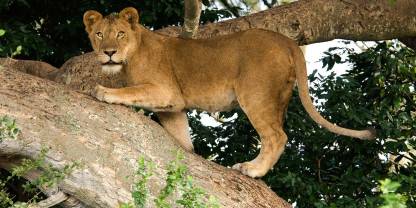Queen Elizabeth National Park is a prime birding destination. Indeed, the park’s checklist of more than 610 bird species is the largest of any protected area in East Africa, reflecting its wide variety of habitats. Swamps bordering the Ishasha Plains and Lake George are home to the localized shoebill. Large flocks of flamingo gather seasonally in salty crater lakes such as Katwe and Bunyampaka, while pelicans are common on the Kazinga Channel. Migratory birds are present from November to April.
Birding Specials Treats for Avid Birders
- African finfoot
- African fish eagle
- African hobby
- African skimmer
- Ayres’s hawk-eagle
- Black bee-eater
- Black-headed gonolek
- Black-rumped buttonquail
- Blue-breasted kingfisher
- Broad-billed roller
- Caspian plover
- Cassin’s flycatcher
- Collared pratincole
- Common sand martin
- Crab-plover
- Great blue turaco
- Great white pelican
- Grey crowned crane
- Grey-winged robin-chat
- Heuglin’s gull
- Lesser flamingo
- Long-crested eagle
- Palm-nut vulture
- Papyrus canary
- Papyrus gonolek
- Papyrus yellow warbler
- Pel’s fishing-owl
- Pink-backed pelican
- Red-chested sunbird
- Rufous-bellied heron
- Shoebill
- Spotted redshank
- Water thick-knee
- Western banded snake eagle
- White-backed night heron
- White-winged tern
- Yellow-bellied wattle-eye
- Yellow-billed stork
- Yellow-throated cuckoo
- Yellow-throated longclaw
Best Time for Bird Watching
The birdlife in Queen Elizabeth NP is good year-round but at its best from late May to September, when rain is less and food is abundant. June and July have the least rain, while April to May and September to November have the most rain. The heavy rains might result in delays due to impassable roads and slippery hiking trails, which may limit your bird-watching time. From November to April, migratory birds can be found in the park.

